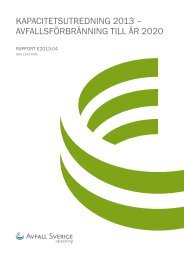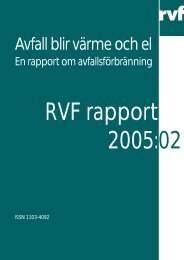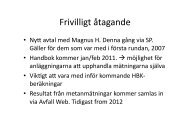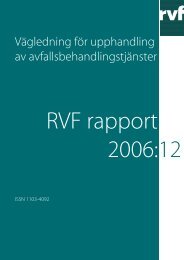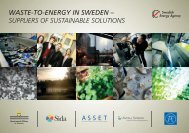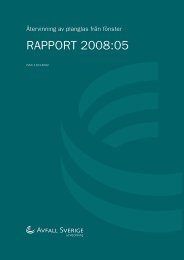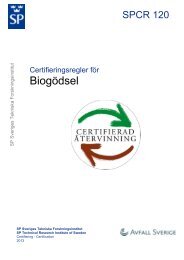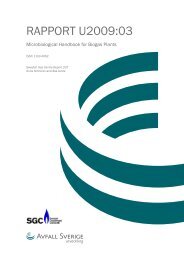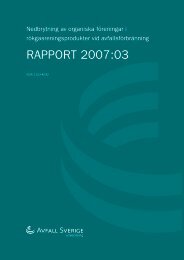SwediSh waSte management |2011 - Avfall Sverige
SwediSh waSte management |2011 - Avfall Sverige
SwediSh waSte management |2011 - Avfall Sverige
You also want an ePaper? Increase the reach of your titles
YUMPU automatically turns print PDFs into web optimized ePapers that Google loves.
Swedish waste <strong>management</strong> 2011Waste EconomicsMunicipalities and producers handle the <strong>management</strong>of household waste. The municipalcosts are charged as a separate waste collectionfee, and the producers’ costs as a feeincluded in the price of the product.The local councils set the municipal wastecollection fees and the producers decide onthe amount of the product fee.As a rule, waste collection fees cover thetotal costs for the municipal waste <strong>management</strong>,but deficits are tax-funded.Administration, such as waste planning, customerservice, invoicing and information areincluded in the costs. The fee must also coverthe service costs at the recycling centers forcollection and handling of bulky waste andhazardous household waste. The rate is oftenbased on one fixed and one variable fee, forexample on one fee for waste collection andone for waste treatment. According to the selfcost principle in the Local Government Act, themunicipalities’ income from fees must notexceed the costs for the municipal waste <strong>management</strong>.The average annual waste collection fee ofa Swedish single-family home is SEK 1,990,according to data from <strong>Avfall</strong> <strong>Sverige</strong> –Swedish Waste Management’s statistics system<strong>Avfall</strong> Web. Apartment households pay anaverage of SEK 1,120 and the average fee forsecond homes is SEK 1,080 annually.Many local authorities, which introducedvoluntary collection of food waste, use the feeas a means of control. Those who choose afood waste subscription may pay a lower feethan those who choose mixed waste.To achieve a higher recycling rate, severalmunicipalities have introduced a fee based onweight, which means that the households payper kilogram of waste collected, on top of thebasic fee. In 2010, 29 municipalities hadimplemented weight-based rates. In thesecases, the collection vehicles are providedwith a scale and equipment to identify eachbin. The total annual cost for weight-basedfees will vary depending on the quantity ofwaste left for collection. The fee variesbetween SEK 1.2-3.2 per kg for bins and bags,combined with different types of bin fees andfixed basic fee.The cost for waste <strong>management</strong> is on averageSEK 670 per person and year, excludingVAT. The municipal cost for collection of wastein bins and bags is on average SEK 190 perperson and year. Treatment of the waste is notincluded in that cost. The basic fee of SEK 270per person covers the cost for the recyclingcenters, treatment of hazardous waste fromhouseholds, planning, information and administration.The statistics come from <strong>Avfall</strong> Weband are based on data from more than onethird of Sweden’s municipalities.Several means are available to reduce theenvironmental impact of waste <strong>management</strong>,to improve resource efficiency and to increaserecycling, either through information or withadministrative means of control. Examples ofadministrative means are regulations and prohibitionssuch as emission limit values andprohibition against landfilling of organic waste.Economical means can work either as “carrot”,through tax reliefs and subventions, or as“stick”, through taxes and charges. ThePolluter Pays Principle (PPP) is applied.Tax on landfilled waste was introduced in2000 as a way to reduce landfilling. The taxwas initially SEK 250 per ton, but has beenraised several times since then. Since July 1st2006, the landfill tax has been set at SEK 435per ton of waste disposed. The landfill site isliable for taxation. On July 1st 2006, a tax onhousehold waste going to Waste-to-Energyincineration was introduced, which was thenabolished on October 1, 2010. Treatmentcharges can vary a good deal from one facilityto another. Some fees include transports,while other fees exclude them. The fees reflectwhat the municipalities have to pay. The trendfor incineration is that fees per ton aredecreasing. Many municipalities still have oldagreements, however, where the reductionhas not yet had an impact. Therefore thereduction is not yet evident in the averagecharges. The information is based on datafrom <strong>Avfall</strong> Web to which about half of themunicipalities have contributed.26





